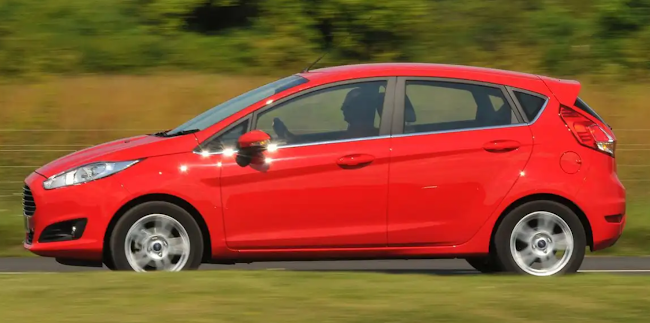Buying and owning a Toyota Etios
Since its first arrival on local soil in 2012, the Toyota Etios for sale has seen sustained demand in both the new- and used car markets. Yet, there’s very little real difference between those early cars and later examples, with its periodic updates leading to a gradual evolution rather than outright revolutions. The Etios is practical, durable and affordable to run, and that’s exactly what budget-conscious buyers crave.

5 key facts you should know about the Toyota Etios
A favourite among fleet owners and private customers alike, there’s much to commend about Toyota’s budget hatchback. Forget about pretty or frivolous: the Toyota Etios is all about value and durability. With bulletproof mechanical bits and easy serviceability, there’s a lot of clever engineering that’s gone into giving the Etios a long, drama-free and safe service life.
1. There’s only one drivetrain available in the Toyota Etios: a 1.5-litre 4-cylinder engine, paired with a 5-speed manual gearbox driving the front wheels.
2. Buyers at Group 1 Cars can choose between hatchback- and sedan body styles, and three trim levels.
3. While the interior panels are made of hard, scratchy plastics, it’s been proven to hold up well with age. Trim rattles are very common, however.
4. Today’s Etios is mechanically almost identical to the earliest ones, with only minor running changes introduced since it was launched
5. While the Etios was developed with an earlier Yaris platform as a starting point, there is very little parts interchangeability between the two models.
Summary
By the time that the Toyota Tazz was finally phased out in 2006, the first-generation (in South Africa) Yaris did a pretty decent job of covering the entry-level market. But, as that car started growing up, Toyota realized that the new-generation model’s increasing sophistication has kick-started an unavoidable move upmarket. What Toyota needed was something Yaris-sized, that could be priced against the wildly successful Polo Vivo.
Fortunately, help was at hand, in the form of the Indian-built Etios. Arriving to mixed initial press reviews, the Etios nonetheless went on to become one of South Africa’s most popular cars. As the years went by, the Etios proved itself to be a rugged and dependable purchase, easy to service and inexpensive to run: the embodiment of traditional Toyota values. Add above-average safety ratings to the mix, and the low-cost Toyota becomes an attractive choice for buyers who place a premium on value and peace of mind.
The best parts
The drivetrain is almost indestructible, and the conservative engineering employed throughout the car means that there isn’t a lot that can go wrong.
With the road conditions in developing markets in mind, the engineers devised a simple and compliant long-travel suspension. This gives the Etios a surprisingly smooth ride quality for its size.
The Toyota Etios is a very compact car (especially in short wheelbase hatchback form), but there’s a surprising amount of cabin space hiding in that small shell.
With its longer wheelbase and larger rear overhang, the Etios sedan has plenty of stretching room for four large-ish adults, as well as a cavernous luggage compartment.
Thanks to a high percentage of high-strength steel in its construction, the Etios has a very sturdy passenger cell, helping it score 4 stars in Global NCAP testing.
It’s not nearly luxuriously appointed even in top-level trim, but all Etios derivatives are fitted with ABS, power steering, air conditioning, and two airbags.
Thanks to its large-for-its-class engine and very lightweight construction, the Etios is one of the stronger performers in its price bracket.
Easy to drive, with a light clutch and steering, and accurate gearchange.
New vs used Toyota Etios
Because the 2019 Etios is still essentially the same car as the 2012 Etios, new ones are pretty much identical to cars dating from 2017, which themselves are basically just the 2015 update with different bumpers, a new radio, and standard alloy wheels to go with the name change from Etios XS to Etios Sprint. But even though the frosting has seen some minor updates through the years, the basic car underneath is almost identical.
And, thanks to it stellar reliability record, there’s no reason to fear buying an older Etios, even if the standard warranty for 3 years or 100 000 km has expired. The only real reason to insist on a new Etios (apart from the new-car smell) is if you want a full-term warranty and service plan for 3 services (30 000 km).
But, once the warranty has expired, there’s only one reason to keep servicing the car at the dealership: the service history. A dealership service record may stand you in good stead when it’s time to sell your Etios, because such a full service record could add a few thousand Rands to your trade-in value. You will however have to pay dealership labour rates, which are generally much higher than those of non-OEM (private) service centres.
Fortunately, it’s not hugely expensive to service an Etios, and, because they’re so easy to work on, it’s easy to find a workshop who’ll perform basic servicing or even major repairs for a lot less than you’d pay at a dealership.
There’s one major upside to buying an older Etios, though, and that’s the initial purchase price. These cars don’t depreciate very quickly, but their values do drop once they’re a few years old or the odometer shows some distance. Very early cars can be had for about half the price of a new one. We have a massive variety of pre-owned Etioses listed here on AutoTrader, and many of them are amazingly affordable.
Average costs of running a Toyota Etios
While it’s impossible to accurately predict how much any car will cost to run in the short- or long term, it’s worth noting a few points:
All new Etioses come standard with a warranty for 3 years or 100 000 km, along with a service plan for 3 services (30 000 km). Toyota also offers a warranty extension plan for used cars at a comparatively small cost, so enquire at your dealership about this option.
Non-OEM servicing will be considerably less expensive than having it performed by a dealership, but we’d recommend using genuine (OEM) service parts.
The Toyota Etios is considered to be a high-risk vehicle by the insurance industry, purely based on its popularity among the long-fingered. As a result, an Etios may be surprisingly expensive to insure. However, remember that an insurance risk profile is extremely dependent on the car’s storage security arrangements, areas in which it travels, and even total mileage accumulated in business use.
With its single drivetrain offering, the various Etios variants deliver similar fuel consumption figures. Toyota quotes an average fuel consumption figure of 6.0 litres/100 km, but owners report average consumption around 7.2 litres/100 km.
The Etios has only ever been available with two tyre sizes: 175/65R14 or 185/60R15. Both of these tyres are easy to find and fairly affordable to replace.
Maintaining your Toyota Etios
If you buy a used Etios with an expired warranty, you can choose to have it serviced and maintained at either the Toyota dealership, or at a private service centre. Toyota parts are generally on the expensive side of reasonable from the agents, and dealer workshop labour rates are quite high as well. If your Etios has an active service plan, you’ll have no reason to take it anywhere else, though, as it’s all included in that perk.
Private (or non-OEM) service centres have much lower labour rates than the agents, and they will have access to second-tier (non-OEM branded, but still produced according to OEM specifications) parts supplies as well. Aftermarket support for Toyota body- and mechanical components is very strong, so you may find that most components can be found at either the agents or from non-OEM parts shops. However, going the non-OEM route may adversely affect your car’s resale value, as this also means that the car won’t have a full dealership service record. It's also advisable to stick to the OEM oil filter: on account of its very small capacity, you want the best possible oil filtration.
The Etios has been on the market long enough for any flaws and failings to be fairly well-known. Fortunately, there are very few reports regarding problems with its mechanical components, with the few known issues relating mostly to the electronically-controlled throttle – usually easily remedied by just cleaning the throttle body.
Additionally, some 2014-2015 vintage Etioses may have noisy cam timing chain, due to a gradual failure of the hydraulic tensioner, so listen out for prolonged rattling from a cold start. Lastly, very early (2012-2013) Etioses may present leaking shock absorbers and rattling front strut mountings. The former are off-the-shelf Monroe parts, and can be bought at most non-OEM spares shops, and the latter will be available from the agents. For the rest, the Etios appears to be as sturdy and durable as you’d expect from a Toyota.
Article from Second Hand Vehicles









Comments
Post a Comment